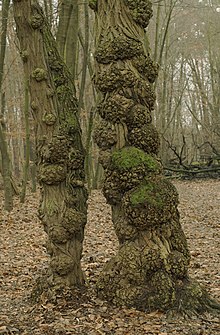Botryosphaeria stevensii
 From Wikipedia the free encyclopedia
From Wikipedia the free encyclopedia
| Botryosphaeria stevensii | |
|---|---|
| Scientific classification | |
| Domain: | Eukaryota |
| Kingdom: | Fungi |
| Division: | Ascomycota |
| Class: | Dothideomycetes |
| Order: | Botryosphaeriales |
| Family: | Botryosphaeriaceae |
| Genus: | Botryosphaeria |
| Species: | B. stevensii |
| Binomial name | |
| Botryosphaeria stevensii Shoemaker, (1964)[1] | |
| Synonyms[2] | |
| List
| |

Botryosphaeria stevensii (Apple sphaeropsis) is a fungal plant pathogen that causes cankers on several tree species including apple and juniper as well as causing cankers on grape vines.[3] It causes branch dieback, possibly affecting a large portion of the tree canopy, and if severe it can kill entire plants.[4]
It was originally found on fallen fruit of Malus pumila in Great Britain and published and described by Berk as Sphaeropsis malorum in 1836 .[5][2] With the epithet 'malorum' derived from the Latin for Apple. It is first seen as multiple very small, black pimples or pustules under the fruit skin before they break through the covering. Then a black conical protuberance appears, which is the spore-case of the fungus. Then a cluster of pale spores appears, on a short stem or pedicel. Later they turn black or black/brown and break off the pedicels. The spores then leave the spore-case by a small aperture at the top of the case. Infections can occur in winter or spring in the US.[6]
Its anamorph was revealed to be Diplodia mutila.[7]
It has been found on Rocky Mountain juniper (Juniperus scopulorum) in windbreak and ornamental plantings in the US. Multiple, coalescing cankers resulted in branch dieback and sometimes tree mortality. The fungus also was pathogenic to and caused canker formation on eastern redcedar (Juniperus virginiana) and Chinese juniper (Juniperus chinensis)[4]
Prevention efforts may include careful selection of plants, including resistant cultivars, planting in well-draining loose soils, exposure to light and plant spacing to reduce moisture retention.[8]
References[edit]
- ^ Shoemaker, Can. J. Bot. 42: 1299 (1964)
- ^ a b "Species Fungorum - GSD Species". www.speciesfungorum.org. Retrieved 5 September 2023.
- ^ Úrbez-Torres, J.R.; Leavitt, G.M.; Voegel, T.M.; Gubler, W.D. (December 2006). "Identification and Distribution of Botryosphaeria spp. Associated with Grapevine Cankers in California". Plant Dis. 90 (12): 1490–1503. doi:10.1094/PD-90-1490. PMID 30780967. S2CID 59364572.
- ^ a b Tisserat, N. A. (14 March 1988). "Plant Disease 1988 | A Canker Disease of Rocky Mountain Juniper Caused by Botryosphaeria stevensii". www.apsnet.org. Retrieved 7 September 2023.
- ^ Smith, Engl. Fl., Fungi (Edn 2) (London) 5(2): 257 (1836)
- ^ New York (State). Legislature. Assembly Documents of the Assembly of the State of New York, Volume 104, Issues 7-8 (1881), p. 36, at Google Books
- ^ Alves, A.; Correia, A.; Luque, J.; Phillips, A. (2004). "Botryosphaeria corticola, sp. nov. on Quercus species, with notes and description of Botryosphaeria stevensii and its anamorph, Diplodia mutila". Mycologia. 96 (3): 598–613. doi:10.1080/15572536.2005.11832956. PMID 21148880. S2CID 203886161.
- ^ Thrush, Paige; Taylor, Nancy J.; Hand, Francesca Peduto. "Botryosphaeria Canker and Die back of Juniper". The Ohio State University. Retrieved 19 February 2023.